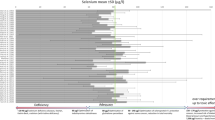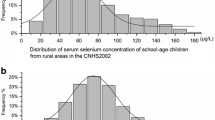Abstract
The trace element selenium is an essential micronutrient for human health and its low levels in serum are implicated in the pathogenesis of several chronic diseases. Therefore, the determination of total selenium in serum may contribute to the assessment of the health and nutritional status of certain populations. The objective of the present work was to determine total selenium in the serum of 506 healthy volunteers that participated in the ATTICA study. Selenium was determined in serum by using the technique of inductively coupled plasma mass spectrometry. The mean serum selenium concentration was determined to be 91.8 ± 33.7 μg/L (N = 506); 87.6% of women and 88.5% of men had serum selenium concentration below 125 μg/L, the cutoff considered to be required for optimal glutathione peroxidase activity. No association was found between serum selenium levels and the gender of the participants while a significant decline of selenium with age (p < 0.0001) was observed. According to our results, no anthropometric, lifestyle, nutritional, or biochemical indices were able to affect the association between serum selenium and age. This result may indicate that other factors such as selenium distribution as well as retention may be affecting the relationship between serum selenium and age.

Similar content being viewed by others
References
Rayman MP (2000) The importance of selenium to human health. Lancet 356:233–241
Navarro-Alarcon M, Lopez-Martinez MC (2000) Essentiality of selenium in the human body: relationship with different diseases. Sci Total Environ 249:347–371
Clark R, Strukle E, Williams S, Manoguerra A (1996) Selenium poisoning from a nutritional supplement. J Am Med Assoc 275:1087–1088
Schrauzer GN (2000) Anticarcinogenic effects of selenium. Cell Mol Life Sci 57:1864–1873
Brown KM, Arthur JR (2001) Selenium, selenoproteins and human health: a review. Public Health Nutr 4:593–599
Papp LV, Lu J, Holmgren A, Khanna KK (2007) From selenium to selenoproteins: synthesis, identity, and their role in human health. Antioxid Redox Signal 7:775–806
Van Cauwenbergh R, Robberecht H, Deelstra H, Picramenos D, Kostakopoulos A (1994) Selenium concentration in serum of healthy Greek adults. J. Trace Elem Electrolytes Health Dis 8:99–109
Schrauzer GN, White DA, Schneider CJ (1977) Cancer mortality correlation studies—III: statistical associations with dietary selenium intakes. Bioinorg Chem 71:23–31
Schulpis KA, Karakonstantakis T, Gavrili S, Chronopoulou G, Karikas GA, Vlachos G, Papassotiriou I (2004) Maternal—neonatal serum selenium and copper levels in Greeks and Albanians. Eur J Clin Nutr 58:1314–1318
Pitsavos C, Panagiotakos DB, Chrysohoou C, Stefanadis C (2003) Epidemiology of cardiovascular risk factors in Greece: aims, design and baseline characteristics of the ATTICA study. BMC Public Health 3:32–41
Katsouyanni K, Rimm EB, Gnardellis C, Trichopoulos D, Polychronopoulos E, Trichopoulou A (1997) Reproducibility and relative validity of an extensive semi-quantitative food frequency questionnaire using dietary records and biochemical markers among Greek schoolteachers. Int J Epidemiol 26:118–127
Hallal PC, Victora CG (2004) Reliability and validity of the International Physical Activity Questionnaire (IPAQ). Med Sci Sports Exerc 35:1381–1395
Bradford M (1976) A rapid and sensitive method for the quantitation of microgram quantities of protein utilizing the principle of dye-binding. Anal Biochem 72:248–254
Delves T, Sieniawska C (1997) Simple method for accurate determination of selenium in serum by using Inductively Coupled Plasma Mass Spectrometry. JAAS 12:387–389
Kallistros G, Evangelou A, Seferiadis K, Vezyraki P, Barboutis K (1985) Selenium and haemodialysis: serum selenium levels in healthy persons, non-cancer and cancer patients with chronic renal failure. Nephron 41:217–222
Kostakopoulos A, Kotsalos A, Alexopoulos J, Sofras F, Deliveliotis C, Kallistratos G (1990) Serum selenium levels in healthy adults and its changes in chronic renal failure. Int Urol Nephrol 22:397–401
Milias G, Nomikos G, Fragopoulou E, Athanasopoulos S, Antonopoulou S (2006) Effects of baseline serum levels of Se on markers of eccentric exercise-induced muscle injury. Biofactors 26:161–170
Thomson CD (2004) Assessment of requirements for selenium and adequacy of selenium status: a review. Eur J Clin Nutr 58:391–402
Li N, Gao Z, Luo D, Tang X, Chen D, Hu Y (2007) Selenium level in the environment and the population of Zhoukoudian area, Beijing, China. Sci Total Environ 381:105–111
Chen CJ, Lai JS, Wu CC, Lin TS (2006) Serum selenium in adult Taiwanese. Sci Total Environ 367:448–450
Ghayour-Mobarhan M, Taylor A, New SA, Lamb DJ, Ferns GA (2005) Determinants of serum copper, zinc and selenium in healthy subjects. Ann Clin Biochem 42:364–375
Lopes PA, Santos MC, Vicente L, Rodrigues MO, Pavão ML, Nève J, Viegas-Crespo AM (2004) Trace element status (Se, Cu, Zn) in healthy Portuguese subjects of Lisbon population: a reference study. Biol Trace Elem Res 101:1–17
Brtková A, Magálová T, Babinská K, Béderová A (1994) Serum selenium levels in Slovak population. Biol Trace Elem Res 46:163–171
Korunová V, Skodová Z, Dĕdina J, Valenta J, Parizek J, Písa Z, Stýblo M (1993) Serum selenium in adult Czechoslovak (central Bohemia) population. Biol Trace Elem Res 37:91–99
Luty-Frackiewicz A, Jethon Z, Januszewska L (2002) Effect of smoking and alcohol consumption on the serum selenium level of Lower Silesian population. Sci Total Environ 285:89–95
Combs GF (2001) Selenium in global food systems. Br J Nutr 85:517–547
Pappa E, Pappas A, Surai P (2006) Selenium content in selected foods from the Greek market and estimation of the daily intake. Sci Total Environ 372:100–108
Bratakos MS, Ioannou PV (1991) Selenium in human milk and dietary selenium intake by Greeks. Sci Total Environ 105:101–107
Niskar AS, Paschal DC, Kieszak SM, Flegal KM, Bowman B, Gunter EW, Pirkle JL, Rubin C, Sampson EJ, McGeehin M (2003) Serum selenium levels in the US population. Biol Trace Elem Res 91:1–10
Arnaud J, Bertrais S, Roussel A, Arnault N, Ruffieux D, Favier A, Berthelin S, Estaquio C, Galan P, Czernichow S, Hercberg S (2006) Serum selenium determinants in French adults: the SU.VI.M.AX study. Brit J Nutr 95:313–320
Safaralizadeh R, Kardar GA, Pourpak Z, Moin M, Zare A, Teimourian S (2005) Serum concentration of selenium in healthy individuals living in Tehran. Nutr J 4:32–36
Hincal F, Başaran N, Yetgin S, Gökmen O (1994) Selenium status in Turkey. II. Serum selenium concentration in healthy residents of different ages in Ankara. J Trace Elem Electrolytes Health Dis 8:9–12
Morisi G, Patriarca M, Marano G, Giampaoli S, Taggi F (1989) Age and sex specific reference serum selenium levels estimated for the Italian population. Ann Ist Super Sanita 25:393–403
Deguchi Y, Ogata A (1991) Relationship between serum selenium concentration and Atherogenic Index in Japanese Adults, Tohoku. J Exp Med 165:247–251
Behne D, Hã-Fer-Bosse T (1984) Effects of a low selenium status on the distribution and retention of selenium in the rat. J Nutr 14:1289–1296
Behne D, Wolters W (1983) Distribution of selenium and glutathione peroxidase in the rat. J Nutr 13:456–461
Suzuki K, Kurasaki K, Okazaki N, Ogra Y (2005) Selenosugar and trimethylselenonium among urinary Se metabolites: dose- and age-related changes. Toxicol Appl Pharmacol 206:1–8
Rayman MP, Infante H, Sargent M (2008) Food-chain selenium and human health: spotlight on speciation. Br J Nutr 18:1–16
Schrauzer GN (2000) Selenomethionine: a review of its nutritional significance. Metabolism and toxicity. J Nutr 130:1653–1656
Acknowledgments
The authors S.L. and S.A.P. thank the European Commission for the funding of a Marie Curie Excellence Grant (contact no. MEXT-CT-2003-002788).
Author information
Authors and Affiliations
Corresponding author
Rights and permissions
About this article
Cite this article
Letsiou, S., Nomikos, T., Panagiotakos, D. et al. Serum Total Selenium Status in Greek Adults and Its Relation to Age. The ATTICA Study Cohort. Biol Trace Elem Res 128, 8–17 (2009). https://doi.org/10.1007/s12011-008-8252-2
Received:
Accepted:
Published:
Issue Date:
DOI: https://doi.org/10.1007/s12011-008-8252-2




